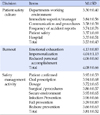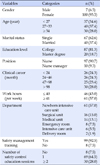3. Kim JY, Hwang EA. A study on improvement of consumer safety in medical services-based on patient safety. Seoul: Korea Consumer Agency;2015.
4. Lee SI. Policy suggestions for improving patient safety. In : 2012 Spring SNUH's Hospital Medical Policy Symposium; 2012 May 22; Seoul: Seoul National University Hospital.
6. Lee KS, Shin MK. Goals and assignments of healthcare accreditation program in Korea. J Korean Med Assoc. 2012; 55(1):7–16. DOI:
10.5124/jkma.2012.55.1.7.
7. Kim YO. A study of factors predicting burnout in hospital staff nurses. J Korean Acad Adult Nurs. 2002; 14(4):591–601.
8. Kim JU, Yang GA, Yun SH. Korean hospital environment associated with patient safety and communication process in recognition of a nurse. Healthc Inf Res. 2004; 10:130–135.
9. Park SJ. A study on hospital nurse's perception of patient safety culture and safety care activity [master's thesis]. Busan: Donga University;2009.
10. Kim JJ, Kim TJ, Seo SE, Jung YS, Shin CH, Kim IS. Fundamentals of nursing. Seoul: Jungdam Media;2006.
12. Lee YJ. Patient safety culture and management activities perceived by hospital nurses [master's thesis]. Daejeon: Eulji University;2011.
13. Lee KH, Lee YS, Park HK, Rhu JO, Byun IS. The influences of the awareness of patient safety culture on safety care activities among operating room nurses. J Korean Clin Nurs Res. 2011; 17(2):204–214.
14. Lee JM, Hong SJ, Park MH. Perception of patient safety culture and safety care activity among ICU nurses. Korean Rev Crisis Emerg Manag. 2013; 9(11):273–290.
15. Nam MH, Lim JH. The influences of the awareness of patient safety culture on safety care activities among nurse in smallmedium sized general hospitals. J Digit Converg. 2013; 11(1):349–359.
16. Lee MJ. Effects of perceived patient safety culture on safety care activities among nurses in small to medium hospitals [master's thesis]. Busan: Donga University;2015.
17. Jeong HJ. Safety culture awareness and safety management activities of operating room nurse [master's thesis]. Seoul: Kyung Hee University;2013.
18. Joo JI. The effect of perceived patient safety culture and job exhaustion on the patient safety performance among operation room nurses [master's thesis]. Gimhae: Inje University;2014.
19. Kizer KW. Large system change and a culture of safety (conference paper). In : Scheffler A, Zipperer LA, editors. Enhancing patient safety and reducing errors in health care. Chicago, IL: National Patient Safety Foundation;1999.
20. Je WY. Hospital workers' perception of patient safety culture in a university hospital [master's thesis]. Seoul: Sungkyunkwan University;2007.
21. Noh YN. Analysis of perception patient safety culture among hospital workforce [master's thesis]. Seoul: Yonsei University;2008.
22. Maslach C, Zimbardo PG. Burnout, the cost of caring. Englewood Cliffs, N.J.: Prentice-Hall;1982.
23. Maslach C, Jackson SE. The measurement of experienced burnout. J Organ Behav. 1981; 2(2):99–113. DOI:
10.1002/job.4030020205.
24. Choi HY. Perfectionism tendency, social support, and burnout among counselors [master's thesis]. Seoul: The Catholic University of Korea;2002.
25. Lee GO. The study on nurse manager leadership and patient safety-related nursing activities [master's thesis]. Seoul: Kyung Hee University;2009.
26. Shin EH. Perception on patient safety culture and safety nursing activity by hospital nurses [master's thesis]. Wonju: Gangneung-Wonju National University;2014.
27. Han NJ. The awareness on patient safety culture and the degree of safe nursing activity of hospital nurses [master's thesis]. Daegu: Kyungbook National University;2012.
28. Gong HH, Son YJ. Impact of nurses' job satisfaction and organizational commitment on patient safety management activities in tertiary hospitals. J Korean Acad Fundam Nurs. 2012; 19(4):453–462.








 PDF
PDF ePub
ePub Citation
Citation Print
Print



 XML Download
XML Download